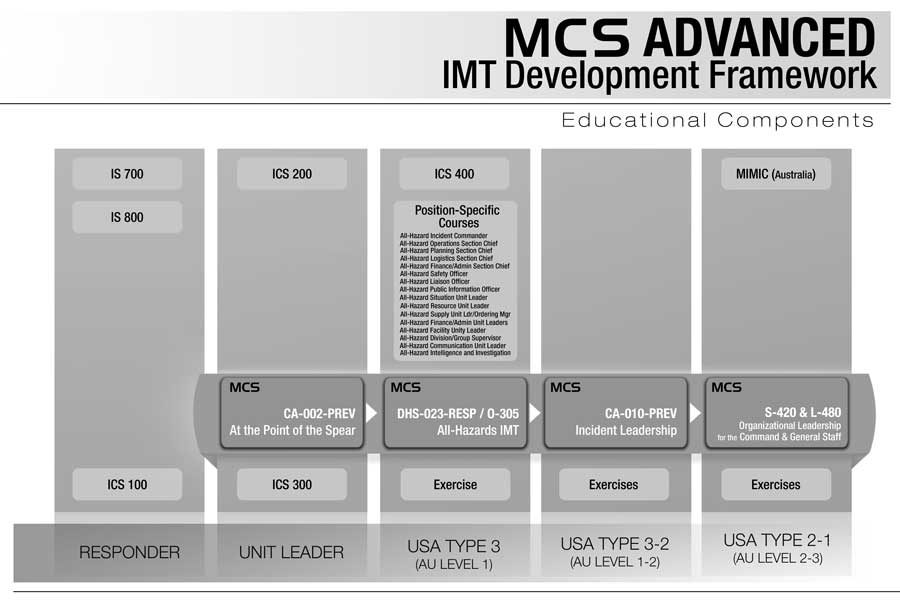The MCS Advanced IMT Development Framework mirrors the approach recommended by the U.S. Fire Administration, FEMA, and NWCG. This framework ensures that individuals receive training appropriate to their needs and experience level as they prepare as members of Incident Management Teams.
IMT preparation begins with programs to increase awareness. Mid-level training includes integration then application of skills through courses, exercises, and field training. Advanced courses target Command and General Staff members who collectively have the responsibility of managing response organizations at the highest levels. These advanced programs focus on staff coordination and alignment to strengthen team synergy.

Note: NWCG recently designated Intent into Action as L-481 and certified that it meets the training requirement for Type 2 C&G positions in the 310-1 and IPQG.
1. Awareness
Students can take beginning courses online or in a traditional classroom setting. These courses introduce the structure of the National Incident Management System (NIMS) and the Incident Command System (ICS). In addition, students learn the terminology of these systems and become familiar with how components of the system work.
The following courses are standard prerequisites for the next level of training as well as for position-specific training:
- IS-700.a NIMS An Introduction – this program is offered as an interactive web-based program or a classroom course.
- IS-800.B National Response Framework, An Introduction – this program is offered as an interactive web-based program or a classroom course.
- ICS 100 Introduction to Incident Command System – this program is offered online by Federal Emergency Management Agency (FEMA).
2. Integration
After completing the introductory courses, students move on to programs that help them learn to better integrate system components as leaders of small teams.
- ICS 200 Introduction to Incident Command System – local agencies and private vendors conduct this 12- to 16-hour program using course materials available through NWCG or FEMA. In addition, the USFA offers an online self-study program.
- ICS 300 Intermediate ICS for Expanding Incidents – state agencies and private vendors conduct this 18- to 24-hour program using course materials available through NWCG . In addition, the USFA offers an online self-study program.
- CA-002-PREV – At the Point of the Spear: Leading and Preparing Emergency Response Units (also titled L-380: Fireline Leadership) – MCS offers this 36- to 38-hour classroom program.
3. Application
Mid-level students move on to programs that help them learn how to apply technical knowledge and leadership principles within the context of incident response.
- ICS 400 Advanced ICS for Command and General Staff Complex Incidents – state agencies and private vendors conduct this 16-hour program using course materials available through NWCG. In addition, the USFA offers ICS-400, Fundamentals Review for Command and General Staff (Q466), an online review of the program.
- Position training for both unit leaders and members of the Command and General Staff. The Emergency Management Institute coordinates the delivery of 15 performance-based, position-specific programs.
- O-305: USFA Type 3 Incident Management Team (also titled DHS-023-RESP: All Hazard Incident Management Team) – private vendors, including MCS, conduct this program using courseware owned by FEMA.
- DHS CA-010-PREV – Incident Leadership (also titled L-381: Incident Leadership) – MCS offers this 38-hour classroom program.
4. Advanced
The most advanced IMT training requires students to manage two parallel responsibilities: application of technical concepts and functional tasks along with the integration of members of the command and general staff. At this level, training programs rely heavily on simulations and hands-on exercises. In these courses, students coalesce ICS, NIMS, position-specific, and leader training to demonstrate their capacity to work as a professional team directing operations in dynamic and chaotic environments.
- Incident Commander Type 3 Simulation – sand table exercises.
- S-420: The Command and General Staff – this five-day, 36-hour course is hosted by state and federal land management agencies as determined by need.
- L-480: Organizational Leadership – this five-day, 32- to 36-hour course for non-operational organizational leaders is hosted by state and federal land management agencies as determined by need. Geographic Area Training Representatives (GATRs) select the training provider, who must be approved and certified by the NWCG Leadership Committee.
- L-481: Advanced Leadership for the Command and General Staff – MCS delivers this five-day, 42.5-hour program which course meets the training requirement for Type 2 C&G positions in the 310-1 and IPQG.
- All-Hazard IMT Field Training – this training consists of assignments shadowing experienced Type 2 and 1 IMT members on actual incidents. The AHIMT program manager coordinates this training.

